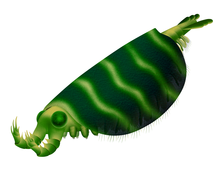Surusicaris
| Surusicaris Temporal range:
| |
|---|---|

| |
| Holotype and only known specimen | |

| |
| Life restoration | |
| Scientific classification | |
| Domain: | Eukaryota |
| Kingdom: | Animalia |
| Phylum: | Arthropoda |
| Order: | †Isoxyida |
| Family: | †Isoxyidae |
| Genus: | †Surusicaris Aria and Caron, 2015 |
| Type species | |
| Surusicaris elegans Aria and Caron, 2015
| |
Surusicaris is an extinct genus of bivalved arthropod, known from the Cambrian Burgess Shale of British Columbia, Canada. It is considered to be closely related to Isoxys, and like it has spined grasping frontal appendages.
Description

The only known specimen (ROM 62976), has a roughly semicircular bivalved carapace, which is approximately 1.49 centimetres (0.59 in) long and 0.89 centimetres (0.35 in) tall. The head has a pair of rounded eyes, and a pair of upward-curling segmented frontal appendages with at least five segments, the second, third and fourth of which bear a spine, with three long spines and at least one short spine on the fifth and terminal segment. The head also has three pairs of other limbs, which are stubby,
Taxonomy and ecology
Surusicaris has been placed as a member of Isoxyida and Isoxyidae, both of which contain only one other genus, Isoxys. Isoxyids are considered to be basal stem-group arthropods. Isoxyids are thought to have been actively swimming predators.[1]
See also
References
- ^ PMID 26038846.
